|
MGT/362T: Change Management and Implementation
|
 = Purchase the Entire Class using this button on left, or purchase Entire Weeks below. = Purchase the Entire Class using this button on left, or purchase Entire Weeks below.
|
|
|
|
|
|
MGT/362T Week 1
Everything listed for Week 1 is included in purchase!!
- MGT/362T Week 1 Discussion Question: Change Management
- MGT/362T Week 1 Practice: Ch 3, Why Change? Contemporary Pressures and Drivers
- MGT/362T Week 1 Practice: Ch 9, Organization Development and Sense-Making...
- MGT/362T Week 1 Practice: Connect Quiz
- MGT/362T Week 1 Apply: Change Management: A Fresh New Idea
MGT/326T Week 1 Discussion: Change Management
Includes A+ Response!
A project or initiative outcome can influence a group of people or organization.
Respond to the following in a minimum of 175 words:
- Why is the role of change management important in an organization? Provide an example where change management was used to improve an organization.
MGT/362T WK1 Practice: Connect Quiz
- Of the six images of managing change, the__________ and_________ images have their foundations in the field of organization theory.
- The___________ image of managing change assumes that change managers receive rather than initiate change.
- Underpinned by the ___________ image, the organizational development (OD) approach is one where its adherents present their developmental prescriptions for achieving change as being based, at least traditionally, upon a core set of values, values that emphasize that change should benefit not just organizations but the people who staff them.
- Underpinned by the _________ image, the sense-making approach maintains that change emerges over time and consists of a series of interpretive activities that help to create in people new meanings about their organizations and about the ways in which they can operate differently in the future.
- The primary background of Likert's organization development (OD) model is:
- Which of the following is NOT a core set of values contained in the organization development (OD) field?
- In the context of the core set of values of the organization development (OD) field, ________ values relate to openness, honesty, and integrity.
- In the context of the core set of values of the organization development (OD) field, ________ values relate to social justice, freedom of choice, and involvement.
- The introduction of and transition to new techniques and behaviors occur during the ________ phase of action research.
- According to Cummings and Worley, which of the following is NOT a skill needed by an organization development (OD) practitioner?
MGT/362T WK1 Practice: Ch 3, Why Change? Contemporary Pressures and Drivers
- True or false: "New broom" top executives often fail to deal with the organization's "sacred cows" and other long-running problems.
- Match Director, Navigator, Caretaker, Interpreter, and Nurturer.
- True or false: Environmental pressures for organizational change include threats but not opportunities.
- Which of the following statements is true of globalization as it develops a new digital profile?
- True or false: A new chief executive serves as one of the potential change drivers from within an organization.
- Identify the true statements about the implications of globalization as it develops a new digital profile. (Check all that apply.)
- True or false: A new chief executive serves as one of the potential change drivers from within an organization.
- In the context of changing expectations of work, which of the following are likely to be advantageous for organizations? (Check all that apply.)
- The way a manager deals with pressures for change that emerge from the need to coordinate work within the team, and develop values and mindsets to improve performance is influenced by the image of a(n) _________ .
- Identify an approach that can be used by organizations for managing older workers.
- Which of the following is true of the demographic trends in the twenty-first century?
- Match the countries (in the left column) with their old-age dependency ratio (in the right
- In a study about why organizations fail to change following crises, Edmondson argues that ___________
MGT/362T WK1 Practice: Ch 9, Organization Development and Sense-Making...
- Identify a characteristic of the classic organization development approach, as illustrated by Beckhard (1969).
- Which of the following is the first step that an organization development (OD) practitioner should take to help organization members solve their own problems and learn to do that better?
- In the context of the images involved in managing change, which of the following images have a common assumption that change managers receive change instead of initiating change? (Check all that apply.)
- Identify the criticisms of organization development as an approach to managing change as identified by French and Bell (1995). (Check all that apply.)
- In response to the criticism of the organization development (OD) approach, Dave Nicholl (1999) proposed the need .
- According to the image of managing change, the organization development approach is one where its followers present their developmental prescriptions for achieving change as being based, at least traditionally, upon a core set of values, values that emphasize that change should help not just organizations but the people who work in them.
- According to the _____ image of managing change, the sense-making approach maintains that change emerges over time and includes a series of interpretive activities that help to create in people new meanings about their organizations and about the manner in which they can operate distinctly in the future.
- Identify a true statement about the classic Managerial (or Leadership) Grid framework developed by Robert Blake and Jane Mouton.
- Identify a characteristic of the classic organization development approach, as illustrated by Beckhard (1969).
- Which of the following steps of the appreciative inquiry (AI) approach to change involves dreaming about the future?
- According to the criticisms of organization development (OD) as an approach to managing change as identified by French and Bell (1995), ________ , validity problems refers to whether the change that took place was caused by the change intervention or a range of other factors.
- Identify a true statement about Positive Organizational Scholarship (POS). Multiple choice question.
- Identify the criticisms of organization development (OD) as an approach to managing change as identified by French and Bell (1995).
- Gervase Bushe and Bob Marshak (2009) characterized the move of “Diagnostic OD” away from the classic approach by contrasting it with what they described as
- According to Karl Weick (2000), the assumption of _________ , states that planned, intended change is necessary to disrupt the forces that contribute to a lack of change in an organization so that there is a lag between environmental change and organizational adaptation.
- Identify the issues raised by Fineman (2006) about the positive organizational scholarship.
- Rank the four steps of the appreciative inquiry approach in the order of their practice.
- A challenge leveled at organization development is earthier the approach and the values underpinning it are _____.
- Identify the whole system techniques used by organization development practitioners to address macro, large-system issues.
- The _____ gives less a set of prescriptions for managers of change and more a set of understandings about how to proceed.
- ______ is a social process of mining construction and reconstruction through which managers understand, interpret, and create sense for themselves and others of their changing organizational context and surroundings.
- Identify the common change assumptions against which Karl Weickʻs sense-making model argues.
- Arrange the phases of a search conference format in the order of their practice from the first to the last
- Identify the benefits of appreciative inquiry as claimed by Fuller et al. (2000)
- Identify the connotations involved in taking a positive organizational scholarship perspective.
- In contrast to traditional organizational development (OD), dialogic OD _____.
- Central to the dialogic organizational development (OD) approach is the view that real change only occurs when _____.
- Traditional organization development techniques focused on _____.
- According to the _____, planned, intended change is essential to disrupt the forces that contribute to an absence of change in an organization so that there is a lag between environmental change and organizational adaptation.
- The two images of managing change, caretaker and nurturer, have a common assumption that change managers _____.
- A criticism of organization development as an approach to managing change so that it _____.
- Unlike Lewinian assumptions, Confucian assumptions are _____.
- One of the connotations involved in taking a positive organizational scholarship perspective is _____, which means that whether one is dealing with celebrations/successes or adversity/problems, the focus is on "life-giving elements."
- The whole system techniques are united by an underlying assumption that _____.
- The _____ image highlights the role of the change managers as a "manager of meaning," that is, it emphasizes that a primary skill of a change manager is the capacity to frame meaning for those involved.
MGT/362T WK1 Apply: Change Management: A Fresh New Idea
(includes 7 Screenshots - 100% Perfect Score)
Narrator: Well, it looks like you're going to have your hands full here. From a company standpoint you, as the CEO, need to move forward and make this change in order to stay ahead of the competition, but there seems to be some resistance. Let's utilize Lewin's
Change Model to better analyze this situation.
Narrator: Based on the model, what would be your first step?
Narrator: So what can you ask the VP and Analyst in the unfreezing stage in order to influence change?
Narrator: Two weeks pass, and you are again with Susan and Rick to discuss the matter...
Rick: XX, based on these results, what is next?
Narrator: Which step in the change process does the introduction of the tablets and
software represent?
Susan: This may be a good plan but how do we make the new technology stick in the minds
of retail associates at each location?
Susan: That sounds like a good plan! Let's give it a few months and see how the change
goes.
Narrator :The team reconvenes a couple months later to look at the results...
Susan: Hi all. It looks like there really has been some significant improvement based on our
changes!
Narrator: What stage in the change process does this support and reinforcement of the new
system represent?
Rick: Thanks everyone. This was a very productive exercise and I hope we can gain a
competitive advantage with this change!
Narrator: Let's see how you did...
|
|
|
|
|
|
| MGT/362T Week 2
Everything listed for Week 2 is included in purchase!!
- MGT/362T Week 2 Discussion: Leading Change
- MGT/362T Week 2 Practice: Ch 6, Vision and the Direction of Change
- MGT/362T Week 2 Practice: Ch 12, The Effective Change Manager: What Does...
- MGT/362T Week 2 Practice: Manager's Hot Seat: Change - More Pain than Gain
- MGT/362T Week 2 Apply: Vision Statement Case Study
MGT/362T Week 2 Discussion: Leading Change
The need for change must be differentiated from the ability to change for it to be successful.
Respond to the following in a minimum of 175 words:
- Discuss the requisite skills a person needs to lead change for a chosen organization.
- How can the organization’s structure accommodate change?
MGT/362T WK2 Chapter 6: Vision and the Direction of Change
- Differentiate between visions and mission statements.
- According to Malnight et al., which of the following are the strategic roles of purpose in organizational growth? (Check all that apply.)
- Which of the following approaches to crafting a vision is used when the chief executive is attracted to the vision and wants it to be adopted by others?
- Match the terms (in the left column) with their descriptions (in the right column).
- Research by Malnight el al. (2019) on rapidly growing companies in America, Europe, and India revealed that a driver of organizational growth is __________.
- Identify the reasons why visions fail. (Check all that apply.)
- Correct Answers for all quiz questions are shown.
- According to Kimberly Boal and Robert Hooijberg (2001), which of the following are the components of visions? (Check all that apply.)
- Match the following word (in left column) with the descriptions (in right column)
- Match the following approaches (in left column) with definition (in right column).
- Visions fail when ___________.
- Which of the following is an example of a mission statement that uses concrete imagery?
- According to Lipton (1996), visions help organizational change by______.
- Match Framing, Scripting, Staging, and Performing (in left column) with description (in right column).
- Correct Answers for all quiz questions are shown.
- Identify the ways which charismatic leaders perform their visions. (Check all that apply.)
- Match the different approaches through which visions may be developed (in the left column) with their disadvantages (in the right column).
MGT/362T WK2 Chapter 12: The Effective Change Manager: What Does...
- True or false: Involvement in change is always associated with a formal leadership or management job title.
- According to James McGregor Burns (1978), _____________ leaders have charisma and inspire other employees to perform "beyond contract".
- According to Gorter et al. (2016), which of the following key issues should a chief transformation officer (CTO) deal with in order to become successful? (Select all that apply.)
- Identify a true statement about the role of middle managers in change management. (Check all that apply.)
- Identify a true statement about change managers.
- In the context of the types of change units identified by Wylie and Sturdy (2018), ____________ are "high profile" change units that are responsible for large-scale change.
- Stjernberg and Philips (1993) use the term _____, derived from the Swedish word "eldsjälar," to describe people who become change managers.
- According to Bass and Avolio (1994), the inspirational motivation in transformational leadership involves developing other employees to higher levels of abilities.
- Which of the following statements is true of a chief transformation officer (CTO)? (Select all that apply.)
- Joseph Bower (1970) was one of the first to recognize the significance of middle managers as _____, exerting upward influence on strategy based on their knowledge of the frontline operational situation and by nurturing, testing, and championing initiatives.
- According to Wylie and Sturdy (2018), __________ are change units that are responsible for helping senior leaders of an organization translate vision and strategy into specific projects.
- Identify a true statement about the experience of a change manager.
- A fundamental issue that change management competency frameworks agree on is that _____.
- _____ refers to an interpersonal style construct that combines social astuteness with the ability to relate well, and otherwise demonstrate situationally appropriate behavior in a disarmingly charming and engaging manner that inspires confidence, trust, sincerity, and genuineness.
- Which of the following reasons led to the significance of change management competencies? (Check all that apply.)
- Intimidators are _____ who focus on weaknesses and insecurities, by the use of coercion, fear, and anxiety.
- __________ refers to individual or group behavior that is informal, ostensibly parochial, typically divisive, and above all, in the technical sense, illegitimate—sanctioned neither by formal authority, accepted ideology, nor certified expertise.
MGT/362T WK2: Manager's Hot Seat: Change: More Pain than Gain
As some organizations are uncomfortable with change, so are their employees.
Employees are often threatened by change and offer resistance to it. Resistance to
change is an emotional/behavioral response to real or imagined threats to an
established work routine. The degree to which employees feel threatened depends on
whether the change is adaptive, innovative, or radically innovative. Lewin's Change
Model helps to understand the stages of change so that they can be best managed.
Employees experience varying levels of change depending on whether the change is
adaptive, innovative, or radically innovative. Adaptive change is the least threatening
as the reintroduction of a familiar practice. Innovative change is somewhat
threatening and involves moderate complexity, cost, and uncertainty. Radically
innovative change is considered extremely threatening and is the most complex,
costly, and uncertain. Employees may be resistant to change for a number of reasons
including surprise and fear of the unknown, fear of failure, climate of mistrust, and
peer pressure. Kurt Lewin proposed a Change Model to explain how to initiate and
manage and stabilize planned change and includes the stages of "unfreezing," "changing," and "refreezing." Each of these factors will be examined through this
activity.
Click the ► button to watch the video. Then, answer the questions that follow.
1. As Rita becomes increasingly frustrated, Carlos tries to offer
______ by telling her how valuable her job is and how valuable she is.
2. As represented in this video case, the merger that occurred
between these two companies represents a(n) _____ force affecting
the need for change.
3. Juan and Rita are having trouble with new employees Peters and
Jackson, indicating which of the four targeted areas of change is
most needed?
4. Carlos wants Juan and Rita to handle the personality issues
themselves. As the company did not make any thought-out change
in anticipation of expected problems, it most likely is being affected
by _______ change.
5.__________, a set of techniques for implementing planned change
to make people and organizations more effective, would have been
useful for this organization.
6. Organizational development would be most useful to this
organization in terms of ________.
MGT/362T WK2 Apply: Vision Statement Case Study
- Check all of the following tangible benefits of well-crafted visions that are primarily cognitive components
- Which of the following statements explains why a vision is more critical to change than a mission statement?
- Which of the statements below are Pendlebury’s three components of vision that are key to change management?
- Match the Approach for crafting a vision to when it is used:
- To what extent do stakeholders influence a plan and subsequent implementation of organization restructuring that accommodates change?
- Barbara, a change manager, has good political skills. She had built a range of relationships across and outside the organization. These characteristics of Barbara’s are an example of the _______ dimension of political skill.
- Sam, a change manager, has many competencies. One particular strength is his ability to gather meaningful data through interviews, surveys, and observations. These characteristics of Sam are an example of the _____________ skills of a change manager.
- An important CMI Change manager competency includes personal responsibility, prioritization and time management, resilience, flexibility, and emotional intelligence. This competency is best described as:
- Which of the following are the undesirable characteristics of a change manager? (Check all that apply).
- When coaching for change, it is important to have a good grasp of: (Check all that apply.)
- The ability to market your skills and persuade internal customers to use your services is an example of:
MGT/362T WK2 Apply: Vision Statement Case Study - BONUS QUESTIONS & ANSWERS
- Based on the vision statements expressed, what is the significance relating to organizational structure?
- In terms of developing an organizational structure accommodating change, which of the following statements is false?
- Organizational redesign and restructuring accommodating change includes, but is not limited to, the following considerations.
- When change in organizational structure is being assessed, the change leader must consider employees as its most important asset. What are some of the step(s) that should be taken when reviewing the human factor of the change equation?
- To what extent do stakeholders influence a plan and subsequent implementation of organization restructuring that accommodates change?
- As the need for organizational change and restructuring is considered by the change manager
- Initial positioning for potential success of organizational change requires
- The implementation of a successful organizational restructuring includes, but is not limited to, the following actions.
- Organizational structuring accommodating change may be due to the organization’s filling of legal action for reorganization in order to remain viable, which presents significant challenges for an assigned change leader. To what extent do the following considerations need to be included in any plan for organizational structuring?
- From a holistic perspective, organizational structuring accommodating change consists of a number of elements that the change manager must assess using evidence-based tools such as environmental scanning that reveals components of the organization’s strengths, weaknesses, opportunities, and threats. Compartmentalization of each may indicate a partial restructuring and/or changes in processes. What would be considered driving factors for in the determination of wholesale restructuring versus partial restructuring?
|
|
|
|
|
|
|
MGT/362T Week 3
Everything listed for Week 3 is included in purchase!!
- MGT/362T Week 3 Discussion: Risks and Biases
- MGT/362T Week 3 Practice Quiz
- MGT/362T Week 3 Apply: Manager's Hot Seat: Change-Innovation in Aisle 9
- MGT/362T Week 3 Practice: Ch5, What Change?
- MGT/362T Week 3 Practice: Ch 8, Resistance to Change
MGT/362T Week 3 Discussion: Risks and Biases
Within an environment where change is needed, you must recognize the obstacles that can make changes difficult to implement. Two of these obstacles are risk, which can be observed by others, and biases, which tend to be personal and internalized.
Respond to the following in a minimum of 175 words:
- Discuss risks and biases for a chosen organization. How can they affect analysis?
- How could you minimize resistance to the use of analytics-based decision-making?
MGT/362T Week 3 Practice: Quiz
- Beltip Corp was forced to shut its operations in a country due to the outbreak of a civil ware in that country. The change in operations experienced by Beltip is most accurately termed as a(n):
- HomeCare Corp is a manufacturer of household utilities. A recent fire at one of its production units caused HomeCare to reduce its production. This change in production is know as a(n):
- ________ are those that are implemented in anticipation of or in response to known trends and development
- ______ are those that just happen or have to happen in response to unforeseen events such as the sudden opening of new market opportunities or accents and failures.
- Incremental change differs from transformational change in that incremental change is
- Which of the following reasons is NOT cited in the text as a cause of resistance that a change manager will have to diagnose before taking action?
- People find it easier to support changes when
- Which of the following factors is most likely to make the people in an organization lose conviction that a change is necessary?
- Which of the following is the most likely negative consequence of excessive change in an organization?
- Which of the following statements is true of resistance to change?
MGT/362T WK3Apply: Manager's Hot Seat: Change-Innovation in Aisle 9
- At the beginning of the video, Priya ends her presentation by asking her colleagues to imagine “a world where you never have to wait in line for your groceries again!” What stage of Lewin’s Change Model is Priya exhibiting?
- Harry grants permission for Priya to start automated sales at one of Bergman’s locations. What stage of Lewin’s Change Model is Harry exhibiting?
- Aiden tells Harry that, “The heart of Bergman’s would still be intact. All Priya is proposing here really is taking the idea of self-checkout a couple steps further…” Based on this statement, Aiden most likely believes automation represents__________ change.
- The need for change to automated sales at Bergman’s most likely arises from a(n) ______ force.
- Aiden and Priya believe automation is necessary so Bergman’s can be _________, not _______.
MGT/362T WK3 Practice: Ch 5, What Change?
- _____ _____ ______ involves a specific strategy that resolves a problem and makes enhancements in ways that do not present a challenge to current thinking and methods. (Enter one word in each blank).
- Arrange the steps in the pattern observed by Everett Rogers in the adoption of innovation in a sequential order
- A challenge a change manager handling disruptive innovations has to deal with is that disruptive innovations _________________.
- Identify the true statements about first-order change. (Check all that apply.)
- The term ____________ ______________________ refers to the shared beliefs, values, and norms that influence the way employees feels, think, and act toward others in an organization.
- The term ___________ is used to mean the adoption of any product, system, program, service, or business model new to an organization.
- Identify an example that is associated with the level of change that involves achieving an outcome without altering working practices of an organization.
- Match the different categories of adopters according to Everett Rogers (in the left column) with their characteristics in the right column.
- Which of the following is a core capability for implementing digital transformations in organizations according to Lindsay et al. (2018)?
- A(n) _______ _______ is described as an environment in which online activity can be interactive influencing actions, solving problems, innovating, and creating new types of organizations that are not controlled by traditional boundaries.
Practice: Ch 8, Resistance to Change
- What happens to resistance to change as we age?
- Increased demand for particular skills; stronger organizational competitive position and improve job security is an example of which outcome that encourages support for change?
- Higher remuneration is an example of which outcome that encourages support for change
- Promotion, power, more discretion in decision making is an example of which outcome that encourages support for change?
- Prestige assignments and matching job titles, a bigger office are examples of which outcome that encourages support for change?
- Increased job scope, visibility are examples of which outcome that encourages support for change?
- Improved physical environment, new equipment are examples of which outcome that encourages support for change?
- Greater sense of challenge and achievement are examples of which outcome that encourages support for change?
- More chances to meet and work with influential people are examples of which outcome that encourages support for change?
- Operational efficiencies are examples of which outcome that encourages support for change?
- What are the five ways that resistance can be used productively?
- Increasing awareness of the change ideas and allowing those affected to think through the implications indicates which way of using resistance productively?
- Those affected needing to understand why their roles have to change indicates which way of using resistance productively?
- Assessing and if appropriate accepting the ideas of those who are resisting; the most outspoken are often closest to the operations affected and care about getting it right indicates which way of using resistance productively?
- Encouraging participation and engagement; people want to be heard, and noting concerns can generate novel and valuable options indicates which way of using resistance productively?
- Resolving any "leftover" issues before going ahead with new plans indicates which way of using resistance productively?
- What are the three categories that resistance to change fall under?
- Which damaging pattern is seen when staff are asked to do too much and have neither the time nor the resources to do it?
- Which damaging pattern is seen when staff are asked to cover too many different kinds of activities, reducing the focus on what they do best?
- Which damaging pattern is seen when the organization is operating close to capacity, denying staff any chance to escape or to "recharge"?
- When readiness for change at work is affected by what else is going on in the individuals life the cause is____________.
- When those who have high dispositional resistance toward change and are therefore less likely to accept change in general, the cause is___________.
- When one is not confident that they have the skills and capabilities that the proposed changes will demand, the cause is___________.
- When the perception that the change will work against the interests of those that will be affected, the cause is_____________
- When mental barriers undermine the acceptance of change initiatives and are seen as inconsistent with the current organizational identity, the cause is__________,
- When does passive resistance (apathy, anxiety) occur?
- When does active resistance occur?
- Our understanding of the nature of the reciprocal relationship that we have with an employer has been called the___________.
- When employees believe that the employer is no longer honoring their side of the deal, the cause of resistance is termed________________.
- The consequence that occurs when managers move frequently between a declining number of positions in a regularly changing structure.
- The consequence that occurs when lower-level employees feel that they have been abandoned, as middle managers seem incapable of handling the change process.
- The consequence that occurs with the resulting sense of chaos when staff find themselves in an uncomfortable limbo between partly abandoned past practices and parly introduced new practices.
- What occurs when new initiatives are launched before the last changes have been fully embedded?
- Resistance to change based on positive intentions, designed to protect the interests of the organization and its employees is caused by_____________.
- What type of resistance are these symptoms of being critical, arguing, starting rumors, using facts selectively, blaming, accusing, manipulating?
- What type of resistance are these symptoms of: agreeing in person but not following through, procrastinating, feigning ignorance, withholding information, standing by and allowing change to fail?
- What stage is employee resistance likely to manifest?
- What stage is middle management resistance likely to manifest?
- When the response to change is the individual wants change to happen and will work to make it happen, or are willing to create whatever structure, systems, and frameworks are necessary, the disposition is__________.
- When the response to change is the individual wants the change to happen and will devote time and energy to making it happen within given frameworks, the disposition is______________.
- When the response to change is the individual acts within the spirit of teamwork, the disposition is_______________.
- When the response to change is the individual sees the virtue in what is proposed, they do what is asked of them, and think proactively about what is needed, the disposition is__________.
- When the response to change is the individual can describe the benefits of what is proposed and are not hostile to them--they do what they are asked and no more, their disposition is__________.
- When the response to change is the individual acts within the letter of the framework, the disposition is_____________.
- When the response to change is the individual sticks to the letter of the framework, the disposition is___________.
- When the response to change is the individual does not accept that there are benefits to what is proposed and does not go along with it, but do enough of what is asked not to jeopardize their position, their disposition is considered____________.
- When the response to change is to interpret the letter of the framework the disposition is said to be________________.
- When the response to change is the individual does not accept there are benefits and have nothing to lose by opposing the proposition and does not do what is asked of him, the disposition is said to be________________.
- When the response to change is the individual works outside the framework the disposition is said to be______________.
- When the response to change is the individual neither supports nor opposes the proposal, just serving their time, the disposition is said to be_____________.
- When the response to change is the individual doesn't care about the framework, the disposition is said to be_________________.
- What are the four stages of a coping cycle?
- This stage of the coping cycle involves a refusal to recognize the situation.
- Phrases like "this can't be happening," or "it will ball blow over" are indicative of which coping cycle?
- When the person is not receptive to new information and refuses to believe that he or she needs to behave differently, or is prepared to make only minor adjustments, they are in which coping stage?
- Which coping stage begins with the recognition and that the situation is real; the past is mourned, and stress may increase?
- This coping stage can be seen as positive, as the individual lets go of the past and becomes more confident in his or her ability to deal with the future.
- This coping stage involves reenergizing and a preparedness to explore the possibilities of the new situation.
- This coping stage involves the individual finally focusing attention on new courses of action.
- What is the recommended focus of finding attractors for the perceived resistors?
- When should the speed of change be quick?
- When should the speed of change move slowly?
- The advantage of this strategy for dealing with resistance to change is that it increases commitment, reconciles opposing views.
- A disadvantage of this strategy for dealing with resistance to change is that it takes time.
- This strategy for dealing with resistance to change should be used when there is a misunderstanding and lack of information.
- The advantage of this strategy for dealing with resistance to change is that it reduces fear and uses individual skills.
- A disadvantage of this strategy for dealing with resistance to change is that it takes time.
- The advantages to this strategy for dealing with resistance to change is that it increases awareness and understanding.
- The disadvantage to this strategy for dealing with resistance to change is that it takes time and can be expensive.
- This strategy for dealing with resistance to change should be used when there is anxiety over personal impact.
- The advantage of this strategy for dealing with resistance to change is that it helps to reduce strong resistance.
- The disadvantage of this strategy for dealing with resistance to change is that it can be expensive and encourages others to strike deals.
- This strategy for dealing with resistance to change should be used when powerful stakeholders interests are threatened.
- The advantage of this strategy for dealing with resistance to change is that it is quick and inexpensive.
- the disadvantage of this strategy for dealing with resistance to change is that future problems might arise from those who feel they were manipulated.
- This strategy for dealing with resistance to change should be used when the cause is that powerful stakeholders are difficult to manage.
- The advantage of this strategy for dealing with resistance to change is quick and overpowers resistance.
- The disadvantage of this strategy for dealing with resistance to change is that the change agent must have power and it's risky if people are angered.
- This strategy for dealing with resistance to change should be used when the resistance is caused by deep disagreements and there is little chance of consensus.
- When there is low agreement concerning both goals and means, which strategies become necessary.
|
I  |
|
I 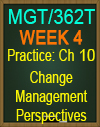 |
I 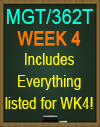 |
I 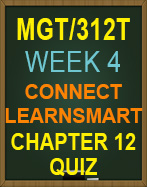 |
|
MGT/362T Week 4
Everything listed for Week 4 is included in purchase!!
- MGT/362T Week 4 Discussion: Change Management Validity Tools
- Practice: Ch 4, What to Change? A Diagnostic Approach
- Practice: Ch 10, Change Management Perspectives
- Practice: Quiz
- Apply: Manager’s Hot Seat: Power & Influence-Riding the Policy Wave
MGT/362T Week 4 Discussion – Change Management Validity Tools
In addition to knowing how to measure the effectiveness of a needed change, you must prepare for all the reasons that a project can fail.
Respond to the following in a minimum of 175 words:
- Discuss change management validity tools for a chosen organization.
- How could you apply analytical frameworks to illustrate possible project outcomes?
Practice: Ch 4, What to Change? A Diagnostic Approach
- Used to strengthen knowledge base/confidence w/regard to what needs to change
- To 'map' the org's environment and help assess appropriate responses
- Less impressed of these diagnostics to support change, but those which focus on the external environment help identify trends/developments to which the org should respond
- More focus on goals/capabilities required to achieve them
- Emphasize images, framing, and cognitive maps are usesful
- May not be convinced about the value of this approach if interest in emergent strategy
- Five ways explicit models are useful
- Six-Box Organizational Model
- 7-S Framework Elements
- 7-S Framework Emphasis
- The Star Model (need alignment)
- Four-Frame Model (same situation in different ways)
- Gap Analysis (reviewing as is state)
- Gap Analysis Pro/Con
- PESTLE Framework (informed guesswork/judgement)
- PESTLE Analysis
- Scenario Planning (best-case/worst-case)
- Elements of Strategy
- The Cultural Web (response to performance problems)
- Cultural Web Model
- Receptive Organizational Context
- Absorptive Capacity
- Force-Field Analysis
- Driving/restraining movement toward a given set of outcomes
- Individual Readiness for Change
- Stakeholder Analysis
- Built-to-Changes
- Understand the use of diagnostic models in planning organizational change
- Use strategic analysis tools to assess the need for organizational change
- Diagnose organizational receptiveness and individual readiness for change, and use those assessments as the basis for action to increase receptiveness and readiness
- Explain the characteristics of the 'built-to-change' organizational model, and assess the applicability, strengths, and limitations of this approach
Practice: Ch 10, Change Management Perspectives
- Identify an accurate statement about the director image of change management.
- True or false: Organizational change is most likely to succeed when thgere are a lot of policies and procedures et up.
- An accurate statement about checklist approaches to change management is that _________.
- Which of the following is true of the DICE model?
- A true statement about the ADKAR change model is that __________.
- The image of change management that underpins the change management approaches associated with the work of large consulting companies is the __________ image.
- In the context of Stouten’s evidence-based approach to change Management, which of the following actions should a change manager take n the Diagnosis (1) step?
- According to managers, which of the following is a reason for the failure of organizational change?
- Which of the following statements are true of the stage models of change management? (Check all that apply.)
- A true statement about John Kotter’s eight-stage model of transformation change is that_____.
- A true statement about ADKAR change model is that ________.
- Which of the following guidelines for managing performance relates to the aspire stage of McKinsey’s 5A model of change?
- Which of the following is a criticism of the stage models of change management?
- An advantage of the tell style of change management is that _________.
- In the context of change management, _______ are most likely to argue that one has to comprehend how the substance, context, and process interact over time to produce desired outcomes in order to understand organizational change.
- Organizational change is most likely to be successful if ______.
- Management is most likely to have the highest degree of control over the change process if the _______ style of change management is used.
- Identify a true statement about process perspectives of change.
- What are the major factors of The Hope Hailey – Balogun Change Kaleidoscope? (Check all the options that apply.)
- An advantage of the tell style of change management is that __________.
Practice: Quiz
- According to Warner Burke, which of the following is a way in which organizational models can be useful?
- According to Warner Burke, which of the following is NOT a way in which organizational models can be useful?
- Which of the following is NOT one of the questions asked when performing gap analysis?
- According to Rosabeth Moss Kanter, segmentalist organizations are characterized by ____.
- Unlike traditional organization designs, built-to-change organization designs ________.
- _______ change theorists and practitioners take an “it depends” approach in which the style of change, especially the style of leadership, is dependent on the scale of the proposed change and the readiness of the staff to receive it.
- The contingency change management approach is underpinned by the _______ image of managing change.
- Process theories see change unfolding over time in a messy and iterative way and thus rely more heavily on the image of a change manager as a(n) ______.
- Which of the following is one of “the seven Cs of change” developed by the UK Chartered institute of Personnel and Development?
- Which of the following companies developed the awareness, desire, knowledge, ability, and reinforcement (ADKAR) model of change?
Apply: Manager’s Hot Seat: Power & Influence-Riding the Policy Wave
- Mark responds to Brianna’s concerns about the new employee end-of-shift policy with “…This is a policy straight from corporate. We have to follow it.” What type of influence tactic is Mark utilizing?
- In response to the new employee end-of-shift policy Brianna proposes that Ollie pay its employees on their breaks instead of making them clock out. Brianna is most likely utilizing the _____ influence tactic.
- Which of the following sources of power does Mark have in enforcing Ollie’s holiday scheduling policy?
- Based on the video, Mark seems to be a ______ leader while Sherry is more of a ____ leader.
- Mark’s apparent favoritism towards Amir is representative of
|
|
|
|
|
|
|
MGT/362T Week 5
Everything listed for Week 5 is included in purchase!!
- MGT/362T Week 5 Discussion: Change Leadership
- Practice: Ch 7, Change Communication Strategies
- Practice: Ch 11, Sustaining Change vs. Initiative Decay
- Practice: Quiz
- Apply: Evidence-Based Analytics and Decision Making
MGT/362T Week 5 Discussion - Change Leadership
As a change leader, you can be a positive influence on change and making change happen, which strengthens your own career and professional capabilities.
Respond to the following in a minimum of 175 words:
- Discuss the differences between managing change and leading change.
- What are the advantages of being a change leader?
Practice: Ch 7, Change Communication Strategies
- Identify a true statement about Whelan-Berry and Somerville’s (2010) views on the change communication process.
- In order to understand the communication process, it is beneficial to perceive the manner in which a transmitter phrases and states the message as a ________ process.
- Match the following genders (in the left column) with their most appropriate behavior (in the right column).
- What are the power tells of dominant individuals? (Check all that apply.)
- Match the following types of behavior that change managers can take to ensure that the change process goes smoothly (in the left column) with their descriptions (in the right column).
- According to Whelan-Berry and Sommerville (2010), change-related ________ is defined as regular two-way communication specifically about the change initiative, its implementation, related successes, challenges and their resolution.
- During the change communication process, it is essential that change managers _______.
- Which of the following is true of the components of interpersonal communication?
- During organizational communication, women are more likely than men to _______.
- Conversations that draw attention to the need for change, whether reactive or proactive, are most likely to be considered ________.
- The term ______ describes the various signs and clues that indicate how powerful someone is – or how powerful they want to be.
- How do emotions influence the change communication process?
- Which of the following statements reflects the view of Deborah Tannen (1995) about the power of communication?
- According to Heracieous and Barrett, which of the following do the deep structures of communication include? (Check all that apply.)
- Which of the following is true of initiative conversations? (Check all that apply.)
- An accurate statement about the process of getting staff buy-in is that ________.
- Identify an attribute of spray and pray communication.
- Geigle and Bailey (2001) argues that change communication is most likely to be effective if change managers __________.
- According to Doug Stace and Dexter Dunphy (2001), _____ need to be based on visionary and inspiring messages.
- Which of the following are characteristics that affect the richness of a communication medium? (Check all that apply.)
- In the change communication process, information ___ ___ concerns the amount and the kind of information that can be transmitted.
Practice: Ch 11, Sustaining Change vs. Initiative Decay
- The problem of sustaining change, or refreezing, in an organization is that it _________.
- Match the praiseworthy reasons for failure (in the left column) with their descriptions (in the right column).
- Which of the following is true about sustaining change in an organization?
- Beer et al. (1990) argue that most change programs do not work because they _________.
- Identify a true statement about redesigning a reward system for sustainability.
- According to Fisher (1995), “______” occurs when management unknowingly sends negative signals about a change.
- From their study of organizational change in six corporations, Beer et al. (1990) found that ____
- To support organizational changes with selection, a number of organizations have adopted “values-based recruitment” systems, which look to select staff _______.
- In the context of sustainability of change, which of the following is true about management practices in an organization?
- According to Giancario Ghislanzoni et al. (2010), Which of the following are included in the top five procedures used by organizations which changes have been successful.
- A benefit of celebrating significant short-term wins is that it _______.
- Which of the following is true about unanticipated consequences in change initiatives?
- Identify the reasons why problems arise in change initiatives.
- A challenge in change management is to __________.
- Identify a true statement about measurement of change.
- In the context of escalation of commitment, it is wise to guard against the tendency of the advocates of change to argue that ___________.
- According to John Kotter (2012), for any transformational change, it is advisable for the change manager to ___________.
- One of the indicators of consistency concerns changes in management practices that are __________.
- Identify the sustainability cautions that can be used to manage the improvement of operation effect.
- Identify a true statement about measurement of change.
- Identify the checks that organization should carry out to measure the comprehensive progress on major change initiatives.
- _______ indicates that novel working methods and performance levels are preserved for an appropriate., Or that new practices and processes are ritualized until they turn Obsolete.
- A factor that causes initiative decay in organization undergoing change is that _________.
- Which of the following advised to avoid escalation of commitment?
- In a learning culture, it is essential to avoid making the fundamental attribution error, which means_________.
Practice: Quiz
- The _____ image of managing change argues that the purpose of communication is to ensure that people understand what is going to happen and what is required of them.
- The _____ image of managing change argues that the purpose of communication is to let people know the "why" of changes, their inevitability, and how best to cope and survive them.
- The _____ image of change views the purpose of communication as a way to ensure that people share similar values and are aware of what actions are appropriate to those values.
- _____ occurs when more new information is provided more quickly than recipients can process
- _____ occurs when meanings are misinterpreted due to intentional or unintentional problems during the sending or receiving of the message.
- According to the _____ image of managing change, with respect to sustaining change, it is the responsibility of the change manager to design the change process and direct others to comply to ensure that planned objectives are achieved.
- According to the _____ image of managing change, with respect to sustaining change, the change manager designs the change process to fit the context, recognizing that modifications will be required and that the outcome may not be as intended.
- According to the _____ image of managing change, with respect to sustaining change, change outcomes will be determined primarily by contextual factors and not by management intervention.
- According to the _____ image of managing change, with respect to sustaining change, the change manager's main role is to help others to develop the capabilities necessary to achieve the intended outcomes of the change.
- According to the _____ image of managing change, with respect to sustaining change, the change manager develops understanding of the meaning and significance of the changes and what will count as successful outcomes.
Apply: Evidence-Based Analytics and Decision Making
- The old adage “nothing is constant but change” implies that organizations are always in a state of flux and business leaders cannot necessarily keep pace with the rate of change. Thus, which of the following statements do you consider the most accurate.
- Refer to Highlight “Change Metrics”. Which of the following statements best describes why the business leaders altered their approach to the organizational crisis.
- Upon review of the effectiveness of a strategic business decision using evidence-based analytics, business leaders may reverse course. Refer to Highlight, “Unanticipated Consequences at Fed Ex”. What factor(s) led to reversal of the new scheduling system?
- Sustainability of change is associated with: Check All That Apply.
- Redesigning roles, staff selection, and redesign of reward systems is linked to
- “Walking the Talk” is a(n)
- When using evidence-based analytics in decision making, measurement is an essential tool in gauging progress. However, the leader needs to assess data based on the following consideration(s). Check All That Apply.
- Analytical tools and decision-making framework models are essential in the business leader toolbox to move an organization forward in refreshing the vision and associated strategies to achieve that vision. In order to sustain the change initiative, what are some actions necessary to prevent initiative decay? Check All That Apply.
- In times of change, strong leadership is essential and cannot be overstated. While the use of metrics may reinforce presentation of a persuasive argument for change to stakeholders, leaders need to project certain qualities and values, which include, but not limited to the following. Check All That Apply
- As noted earlier, today’s business leaders are equipped with a “toolbox” to improve strategic decision-making involving change. However, not all initiatives should be sustained, which was referenced in the FedEx case. In distinguishing between “blameworthy” and “praiseworthy” change initiatives, what guidelines are relevant in determining the difference?
|
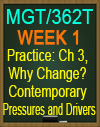
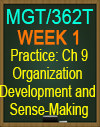
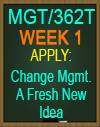
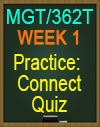
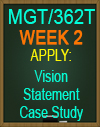
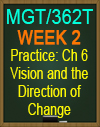
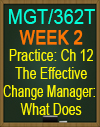
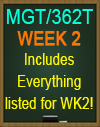
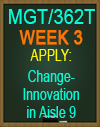
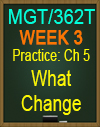
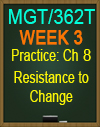
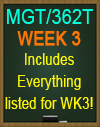

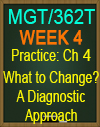



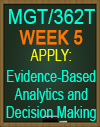
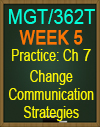
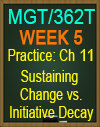
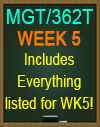

 = Purchase the Entire Class using this button on left, or purchase Entire Weeks below.
= Purchase the Entire Class using this button on left, or purchase Entire Weeks below.

